14 Species of Hawks in Texas (With Pictures & Info)
Last Updated on
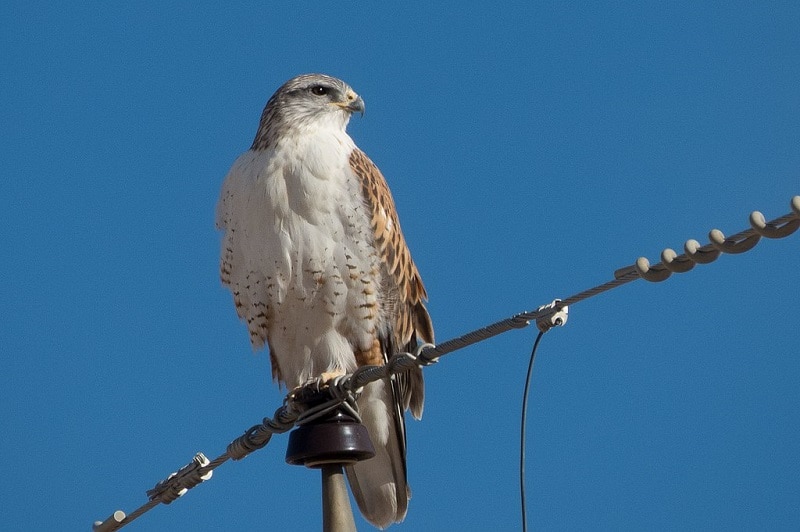
Texas is the largest state in the continental United States. Since it is situated just north of Mexico, it is directly on the migratory path of many bird species, including hawks. This positions the state to have a large variety of hawk species, with there being 14 species of hawks in Texas.
The following is a list of hawks commonly seen in Texas, some species that are only found seasonally in the state and others that have been seen only rarely.

1. Broad-Winged Hawk
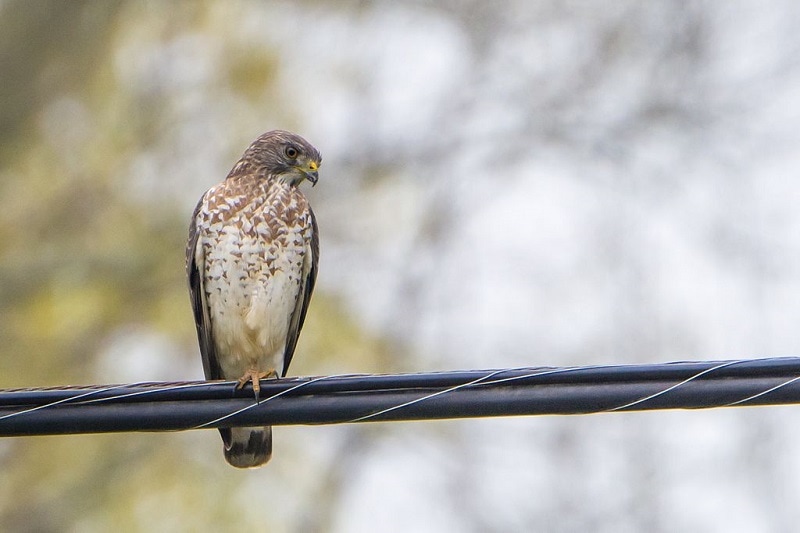
- Scientific name: Buteo platypterus
- Lifespan: 10-14 years
- Wingspan: 29-39 inches
- Length: 13-17 inches
Found in Texas only during summer, from April to August, the Broad-Winged Hawk will head north for the winter. They are small to medium-sized birds with broad wings, hence their name, with dark brown plumage above and brown-barred, white plumage underneath. Broad-Winged hawks migrate every year in flocks (or “kettles”) by the thousands, a common sight in large cities of southern Texas.
2. Common Black Hawk
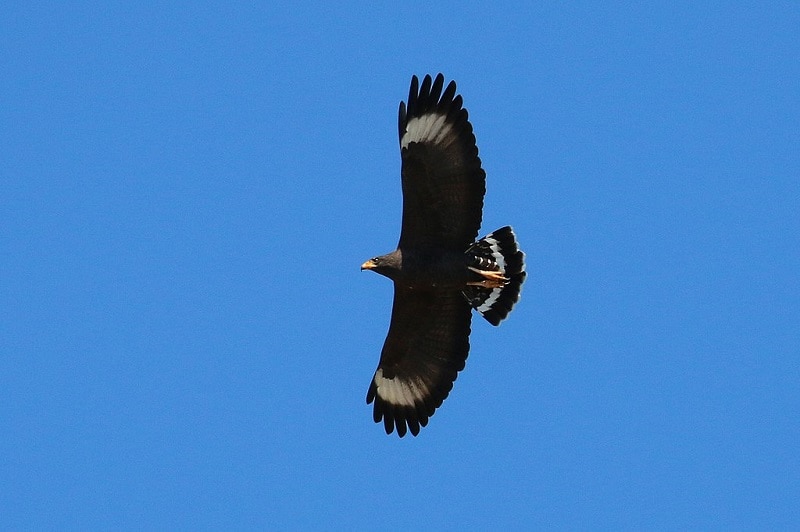
- Scientific name: Buteogallus anthracinus
- Lifespan: 10-13 years
- Wingspan: 40-50 inches
- Length: 18-21 inches
The Common Black Hawk is typically only found in the far western regions of Texas and is a rare sighting. They are a desert species mostly found near the wooded streams and rivers where they like to hunt, and they nest high up in large trees. They have broad wings and a short, white-banded tail, with dark black plumage and long yellow legs.
3. Cooper’s Hawk
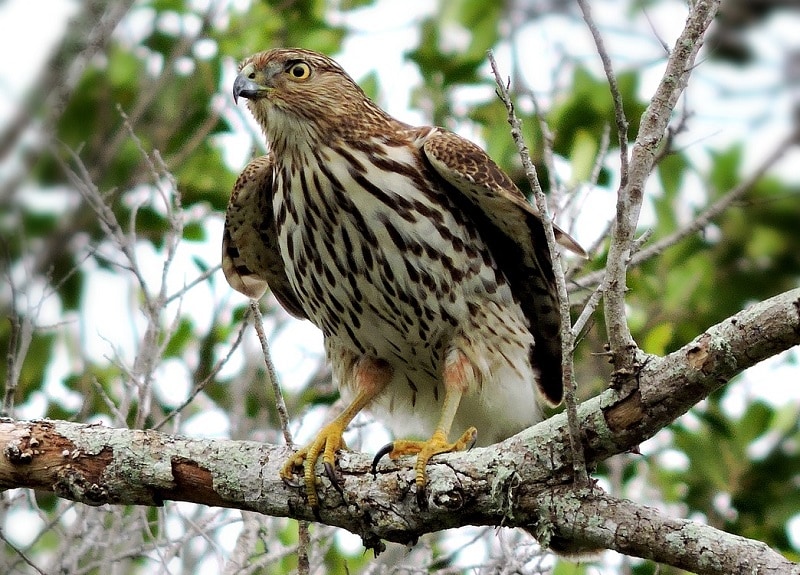
- Scientific name: Accipiter cooperii
- Lifespan: 10-12 years
- Wingspan: 24-39 inches
- Length: 14-20 inches
Often confused with similar Sharp-Shinned Hawk, the Cooper’s Hawk is a fair bit larger and is a common hawk species in the United States. They have a year-round range through most of Texas and have a varied coloring that can range from blue-grey to brown-grey, with a creamy-white underside broken by red-brown bands. Due to their prey consisting of mostly small birds, they are commonly seen in suburban areas and are notorious for stalking bird feeders.
4. Ferruginous Hawk
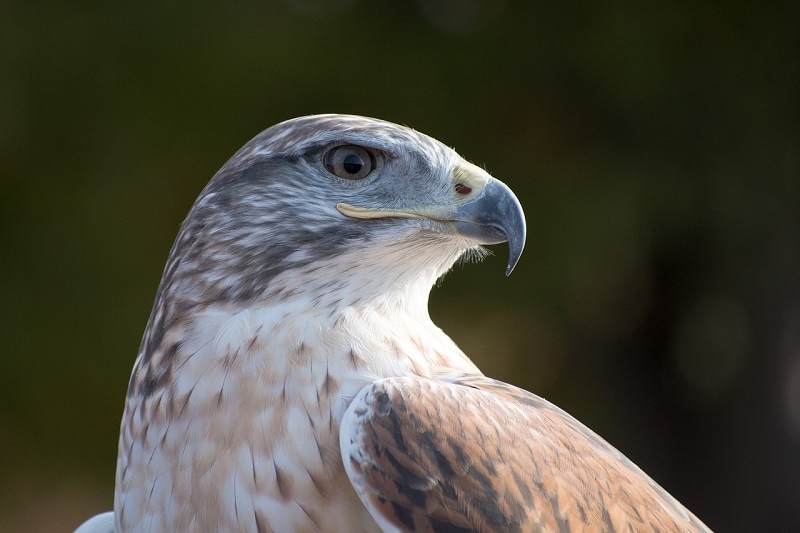
- Scientific name: Buteo regalis
- Lifespan: 16-20 years
- Wingspan: 53-56 inches
- Length: 20-25 inches
Found in Texas only during winter months, the Ferruginous Hawk is the largest species of hawk found in the state. They have a rusty brown plumage from which they get their name — ferruginous means “rust-colored” — with a white, brown-banded breast. They prefer open plains and grasslands for hunting and can often be found hunting and roosting in groups of five to 10 birds.
5. Gray Hawk

- Scientific name: Buteo plagiatus
- Lifespan: 6-10 years
- Wingspan: 25-35 inches
- Length: 15-24 inches
The Gray Hawk is most common in Central America, but their range does extend to Southern Texas. They have gray plumage over their entire body, with black and white stripes on the tail, and tend to stick to densely wooded areas, preferably near water. They feed on small mammals, reptiles, and frogs but have a special penchant for lizards.
6. Harris’s Hawk

- Scientific name: Parabuteo unicinctus
- Lifespan: 10-20 years
- Wingspan: 40-46 inches
- Length: 18-24 inches
The Harris’s Hawk is found mostly in the southern parts of Texas but can also be seen in the central and eastern parts of the state. Unlike many other hawk species, Harris’s Hawks are known as a social species, often hunting in groups of up to seven birds. They have dark brown plumage, with red feathers on their wings and legs and a white-tipped tail.
7. Northern Harrier

- Scientific name: Circus hudsonius
- Lifespan: 12-16 years
- Wingspan: 38-48 inches
- Length: 16-20 inches
The only Harrier species indigenous to North America, the Northern Harrier Hawk spends their winters in Texas, with breeding grounds as far north as Canada. Unusually among hawk species, Northern Harriers will mate with several females during breeding season. They prefer open grasslands and wetlands and nest on the ground in dense vegetation rather than in trees. Northern Harriers have dark grey or brown upper plumage, with white plumage below and grey or brown banding.
8. Red-Shouldered Hawk
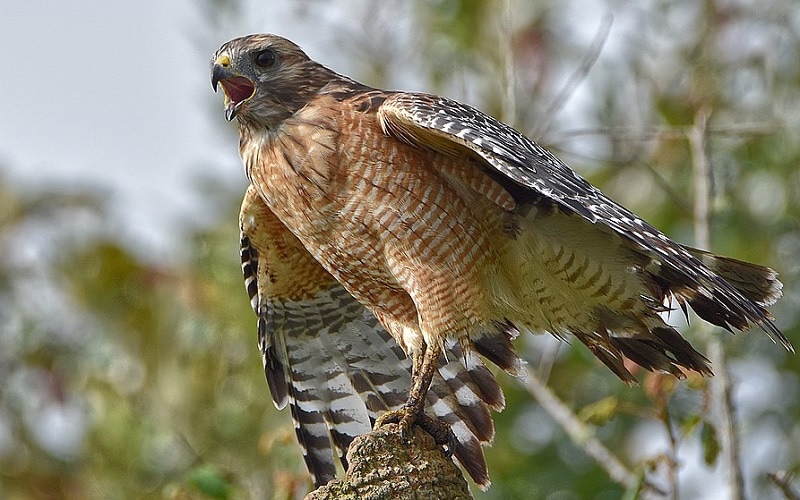
- Scientific name: Buteo lineatus
- Lifespan: 15-19 years
- Wingspan: 35-50 inches
- Length: 15-25 inches
The Red-Shouldered Hawk has distinctive red and brown streaks that line the upper parts of their wings, giving them their name and making them arguably one of the most attractive species of hawk. They are medium- to large-sized birds that prefer woodlands and forests, especially near rivers, ponds, and wetlands. These hawks are one of the few species that return to the same nesting site every year.
- See also: 14 Species Of Hawks in California
9. Red-Tailed Hawk

- Scientific name: Buteo jamaicensis
- Lifespan: 20-25 years
- Wingspan: 45-55 inches
- Length: 18-26 inches
One of the most common hawks in Texas and the whole of North America, the Red-Tailed Hawk is a year-round resident of Texas. They are also one of the largest hawk species in the United States and are an adaptable species that can live in a wide range of environments, likely the reason for their high population in the U.S. They are easily recognizable by their size, red tail feathers, and a dark line of spots across their belly.
10. Rough-Legged Hawk

- Scientific name: Buteo lagopus
- Lifespan: 5-18 years
- Wingspan: 50-60 inches
- Length: 18-24 inches
The Rough-Legged hawk is found in Texas only during the winter and can be tricky to identify from the air. Perched on a tree or pole, they are easily spotted with their characteristic feathered legs, one of only two species that have feathers all the way down to their toes. They migrate as far north as Alaska during breeding season.
11. Sharp-Shinned Hawk

- Scientific name: Accipiter striatus
- Lifespan: 3-10 years
- Wingspan: 17-25 inches
- Length: 9-15 inches
A small to medium-sized hawk that is similar in appearance to the Cooper’s Hawk, the Sharp-Shinned Hawk is one of the smallest species in North America. They have a non-breeding range throughout Texas and migrate north to Canada and Alaska during breeding season. They prefer wooded areas and are rarely seen out in the open.
12. Swainson’s Hawk

- Scientific name: Buteo swainsoni
- Lifespan: 15-20 years
- Wingspan: 45-55 inches
- Length: 17-22 inches
Swainson’s Hawks are medium- to large-sized hawks that can be found throughout most of Texas during the summer months and migrate north to breed during winter. They are commonly known as the “locust hawk,” as their diet consists mostly of small insects, predominantly locusts. They are easily identifiable by their red-brown chest, white throat, and off-white belly.
13. White-Tailed Hawk

- Scientific name: Geranoaetus albicaudatus
- Lifespan: 7-10 years
- Wingspan: 46-56 inches
- Length: 17-24 inches
A common hawk in South America, the White-Tailed Hawk is rare in North America and is only found in the southern-most parts of Texas. They are typically light-blue-grey on top and white below, with subtle banding on their chest and belly, although there is a darker morph of the species too. They are grassland hunters and prefer to live near open areas.
14. Zone-Tailed Hawk

- Scientific name: Buteo albonotatus
- Lifespan: 4-7 years (approximately; there have been no extensive studies on longevity in the species)
- Wingspan: 47-55 inches
- Length: 17-22 inches
Zone-Tailed Hawks are uncommon in Texas but can be found in the southern and western regions of the state. They can be confused with Turkey Vultures due to their gray-black plumage and large size, an advantage when hunting, as prey may mistake them as harmless. In contrast with vultures, however, outside of pair-bonding, these hawks are wholly solitary and do not hunt in pairs or groups.
You might also be interested in:
Featured Image: Bettina Arrigoni, Wikimedia Commons
About the Author Robert Sparks
Robert’s obsession with all things optical started early in life, when his optician father would bring home prototypes for Robert to play with. Nowadays, Robert is dedicated to helping others find the right optics for their needs. His hobbies include astronomy, astrophysics, and model building. Originally from Newark, NJ, he resides in Santa Fe, New Mexico, where the nighttime skies are filled with glittering stars.
Related Articles:
Monocular vs Telescope: Differences Explained (With Pictures)
How to Clean a Refractor Telescope: Step-by-Step Guide
How to Clean a Telescope Eyepiece: Step-by-Step Guide
How to Clean a Rifle Scope: 8 Expert Tips
What Is a Monocular Used For? 8 Common Functions
How to Clean a Telescope Mirror: 8 Expert Tips
Brightfield vs Phase Contrast Microscopy: The Differences Explained
SkyCamHD Drone Review: Pros, Cons, FAQ, & Verdict
